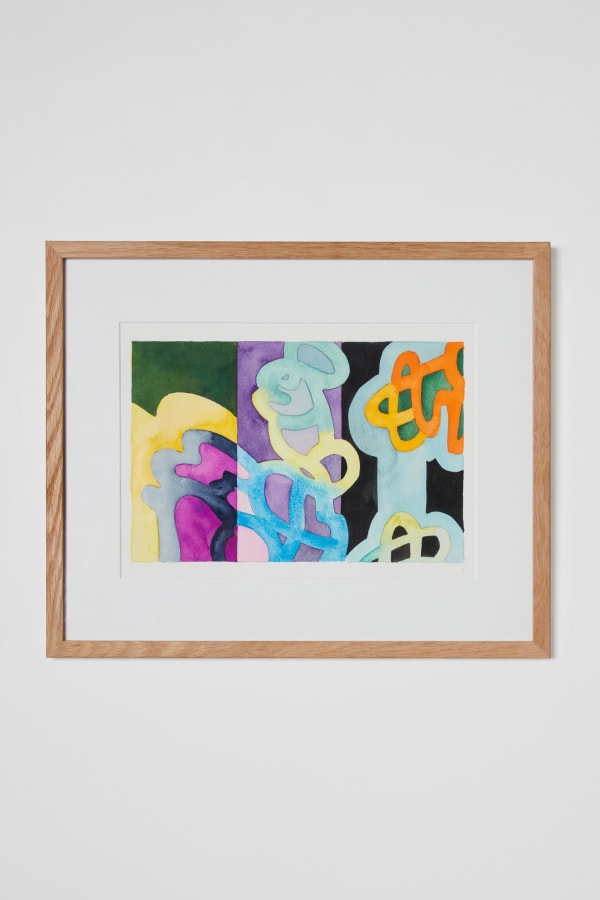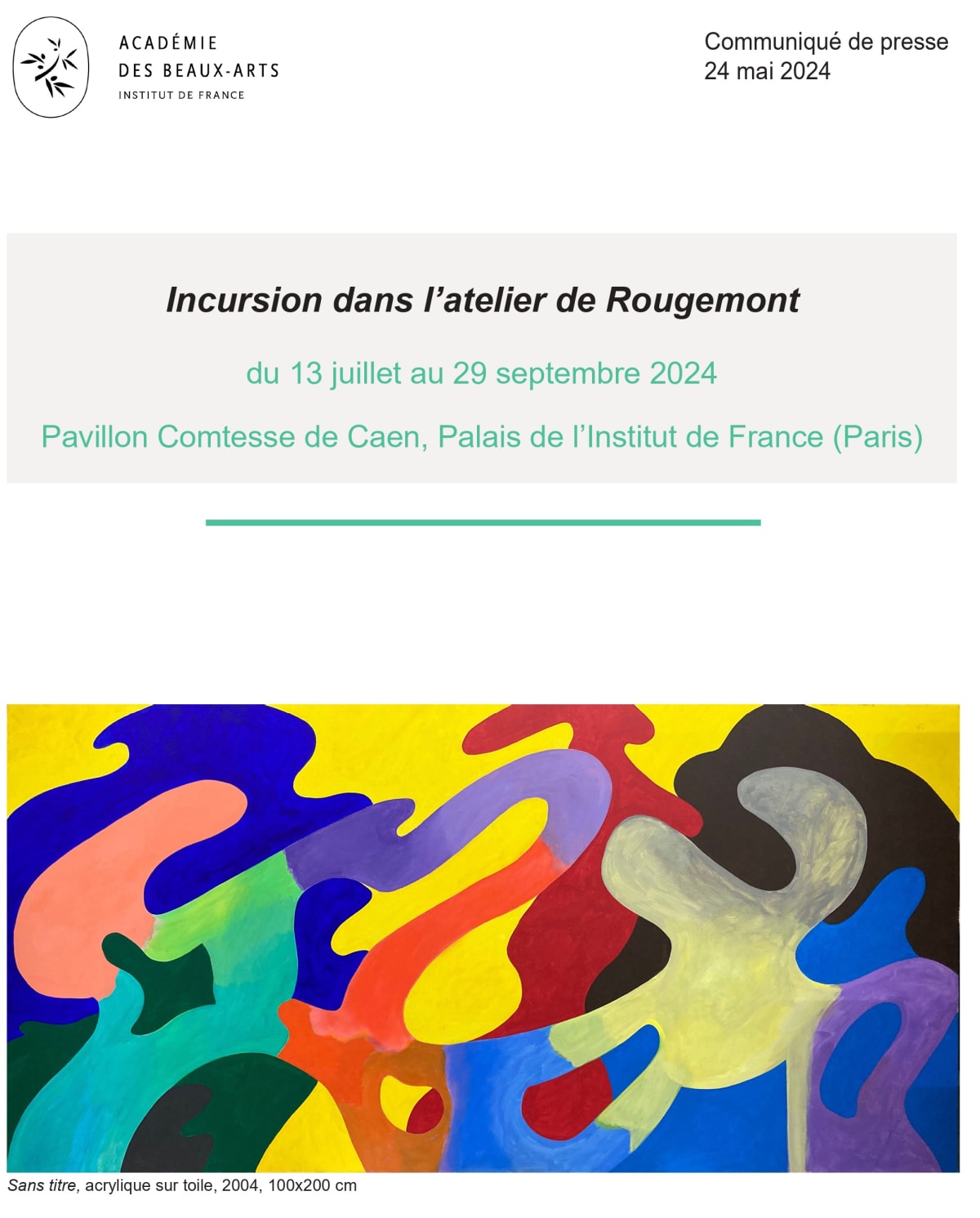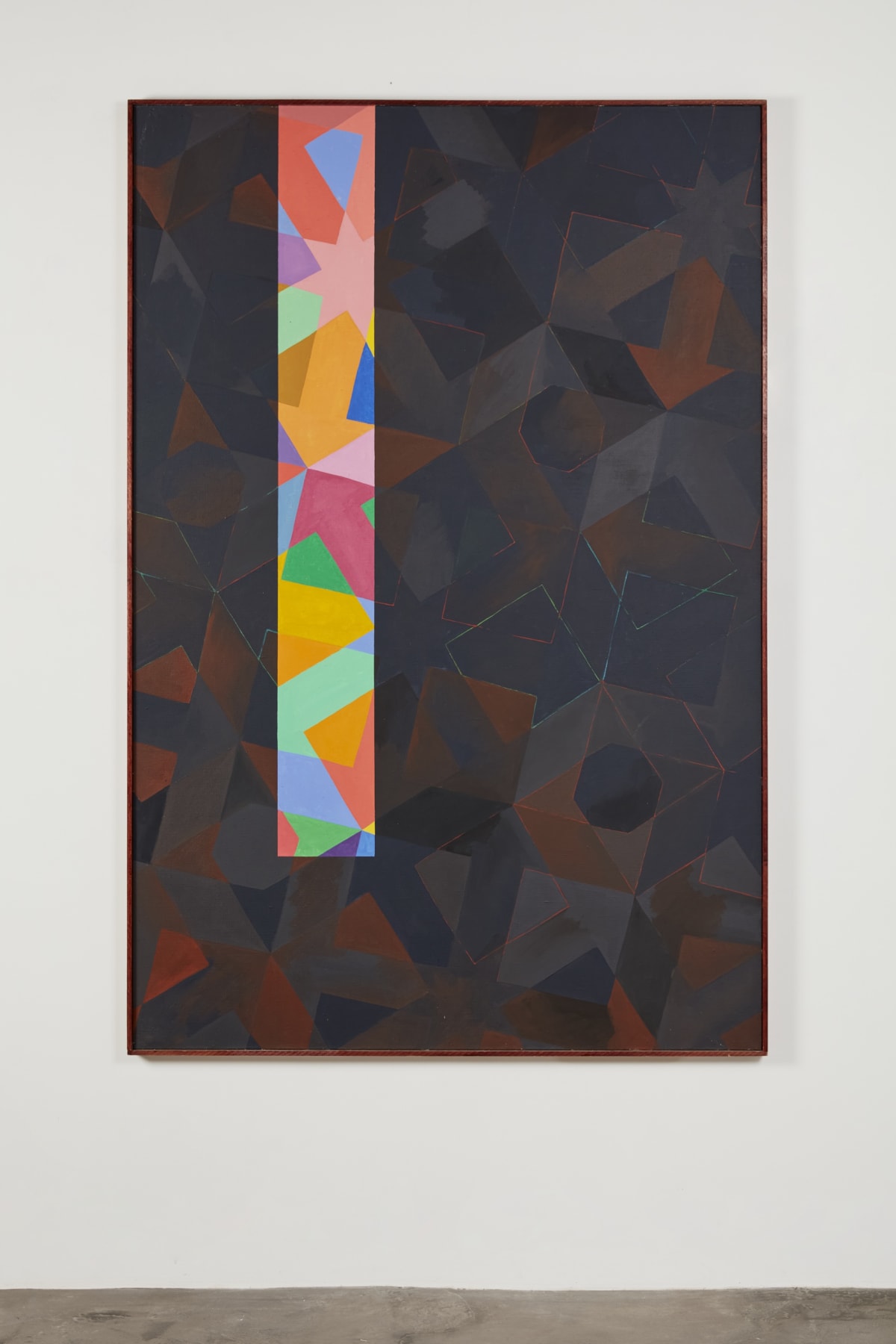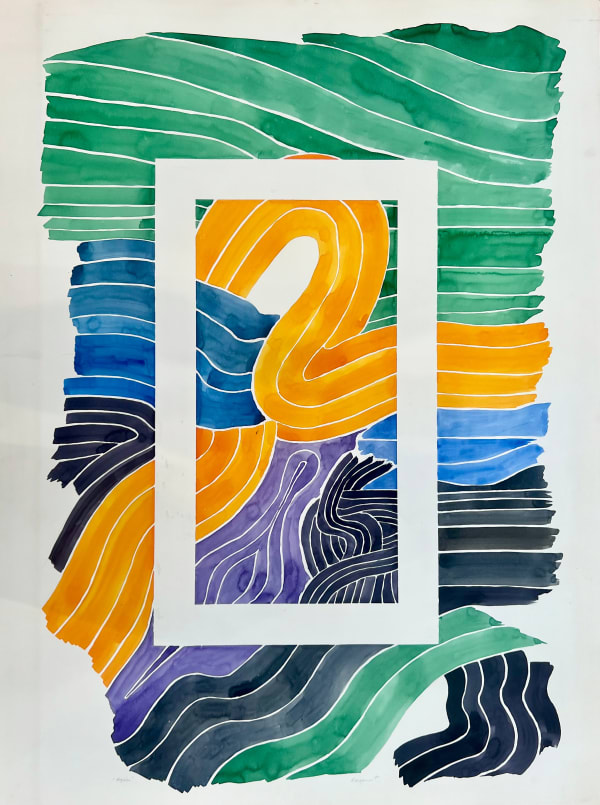Overview
La galerie a l'honneur de représenter la succession de l'artiste français Guy de Rougemont (1935 - 2021), dont l'œuvre a fait l'objet d'une rétrospective à l'Académie des Beaux-Arts (commissariat mené par Julie Goy et Adrien Goetz) à l'été 2024 et d'une importante monographie parue le 6 septembre dernier aux éditions Norma.
Guy de Rougemont naît en 1935 à Paris. Très tôt, il se confronte à l’art, pratiquant l’aquarelle avec sa grand-mère paternelle américaine, à laquelle il doit, disait-il, ses premiers élans artistiques. Il est admis en 1954 à l’École Nationale Supérieure des Arts Décoratifs et privilégie la pratique de la peinture, s’inscrivant dans l’atelier du peintre français Marcel Gromaire (1892-1971).
Ses premières expositions personnelles se tiennent à l’étranger, notamment à la d’Arcy Gallery de New York en 1962. De 1962 à 1964, il est boursier de l’État à la Casa Velasquez de Madrid et présente ses travaux à la galerie Ateneo Mercantil de Valence en 1964. Il passe ensuite l’année 1965 à New York chez ses amis Jean et Irène Amic, où il rencontre les jeunes artistes de la scène new yorkaise tels que Andy Warhol, Robert Indiana et Frank Stella. Il s’ouvre à la peinture acrylique grand format, mesure la force des formes simplifiées et de la couleur en aplat. Son oeuvre est souvent assimilée aux courants du Pop Art et du Minimalisme, dont il s’inspire des formes, sans pour autant s’en revendiquer. Quatre grandes périodes peuvent être esquissées dans la carrière de Guy de Rougemont, définies à partir des formes géométriques composant ses oeuvres.
Dès les années 1965, il introduit l’ellipse, qu’il développe sur la surface de sa toile. En 1967, il réalise l’environnement pour le Hall Fiat des Champs Élysées à Paris, plaçant des toiles découpées en forme d’ellipses dans le lieu d’exposition, instaurant un dialogue entre art et automobile. À la suite de cet évènement, il crée ses premiers objets en volume. Durant la décennie 1970, il commence à utiliser le cylindre, une forme géométrique qu’il considère comme la parfaite combinaison de cercles et de lignes. Il l’utilise pour placer ses volumes polychromes dans l’espace, réalisant de grands cylindres, également surnommés « totems », « colonnes » ou encore « balises », qui prennent place dans l’espace urbain, comme sur la place Albert Thomas à Villeurbanne, ou dans l’espace intérieur, comme ses Colonnes de table. La Mise en couleurs d’un musée, au Musée d’Art moderne de la Ville de Paris en 1974, marque l’apogée de son usage du cylindre. L’artiste recouvre les vingt colonnes du portique du musée de P.V.C coloré, de manière éphémère, jouant avec les frontières, plaçant son oeuvre entre intérieur et extérieur, sur le parvis du musée. À la fin de la décennie et particulièrement durant les années 1980, l’artiste délaisse le cylindre pour la surface tramée. Il réalise l’une de ses oeuvres majeures en 1986, la mosaïque de marbres colorés qui orne le pavement du parvis Bellechasse, devant le musée d’Orsay à Paris.
Finalement, à partir des années 2000 et jusqu’à la fin de sa vie, l’artiste déploie la ligne serpentine, signant un retour marqué à l’usage de formes courbes. Ses sources d’inspiration lui viennent de l’observation des Maîtres de l’histoire de l’art, en particulier Henri Matisse et des artistes qui lui sont contemporains, notamment son ami de longue date Eduardo Arroyo (1937 2018), qui déclare à son sujet qu’il « applique son langage à l’univers ».
L’artiste veut, comme de nombreux autres artistes du XXe siècle, décloisonner les arts. Son objectif est de placer la couleur dans l’espace de la vie quotidienne, ce qui passe par l’usage de l’ensemble des moyens artistiques mis à sa disposition. Néanmoins, il se décrit comme étant peintre avant tout: cette distinction est officialisée par ses pairs lors de sa nomination à l’Académie des Beaux-Arts au siège de peintre, en 1997.
Guy de Rougemont s’est éteint en août 2021.
Texte de Julie Goy, historienne de l’art et co-comissaire de l'exposition Incursion dans l'Atelier de Rougemont, Palais de l’Institut de France, Paris 6e.
We are delighted to announce the representation of the Estate of French artist Guy de Rougemont (1935 - 2021) The gallery will dedicate a solo exhibition to his work at the fall of 2024 at the occasion of Paris art week.
Guy de Rougemont was born in Paris in 1935. He was exposed to art from an early age, practising watercolours with his paternal American grandmother, to whom he owed his first artistic impulses. In 1954, he was admitted to the École Nationale Supérieure des Arts Décoratifs and focused on painting, enrolling in the studio of French painter Marcel Gromaire (1892-1971).
His first solo exhibitions were held abroad, notably at the d'Arcy Galleries in New York in 1962. From 1962 to 1964, he received a state scholarship to the Casa Velasquez in Madrid, and exhibited his work at the Ateneo Mercantil gallery in Valencia in 1964. He then spent the year 1965 in New York with his friends Jean and Irène Amic, where he met young artists from the New York scene such as Andy Warhol, Robert Indiana and Frank Stella. He opened up to large-format acrylic painting, and discovered the power of simplified forms and flat colours. His work is often equated with the Pop Art and Minimalism movements, whose forms he draws inspiration from, without claiming to be his own. Guy de Rougemont's career can be divided into four main periods, based on the geometric shapes that make up his work.
In 1965, he introduced the ellipse, which he developed on the surface of his canvas. In 1967, he created the environment for the Fiat Hall on the Champs-Élysées in Paris, placing canvases cut out in the shape of ellipses in the exhibition space, establishing a dialogue between art and the automobile. Following this event, he created his first volume objects. In the 1970s, he began to use the cylinder, a geometric shape that he saw as the perfect combination of circles and lines. He used it to place his polychrome volumes in space, creating large cylinders, also known as "totems", "columns" or "beacons", which took their place in urban spaces, such as the Place Albert Thomas in Villeurbanne, or in interior spaces, like his table columns. "Mise en couleurs d'un musée", at the Musée d'Art moderne de la Ville de Paris in 1974, marked the high point of his use of cylinders. The artist ephemerally covered the twenty columns of the museum's portico with coloured PVC, playing with boundaries and placing his work between interior and exterior, on the museum's forecourt. At the end of the decade, and particularly during the 1980s, the artist abandoned the cylinder for the screened surface. He produced one of his major works in 1986, the coloured marble mosaic that adorned the pavement of the Bellechasse forecourt, in front of the Musée d'Orsay in Paris.
Finally, from the 2000s until the end of his life, the artist used serpentine lines, marking a strong return to the use of curved forms. His sources of inspiration come from observing the Masters of art history, in particular Henri Matisse, and artists who were his contemporaries, notably his long time friend Eduardo Arroyo (1937-2018), who said of him that he "applies his language to the universe". Like many other twentieth-century artists, Rougemont wanted to decompartmentalise the arts. His aim was to place colour in the space of everyday life, using all the artistic means at his disposal. Nevertheless, he describes himself as a painter first and foremost: this distinction was made official by his peers when he was appointed to the Académie des Beaux-Arts as a painter in 1997.
Guy de Rougemont died in August 2021.
His first solo exhibitions were held abroad, notably at the d'Arcy Galleries in New York in 1962. From 1962 to 1964, he received a state scholarship to the Casa Velasquez in Madrid, and exhibited his work at the Ateneo Mercantil gallery in Valencia in 1964. He then spent the year 1965 in New York with his friends Jean and Irène Amic, where he met young artists from the New York scene such as Andy Warhol, Robert Indiana and Frank Stella. He opened up to large-format acrylic painting, and discovered the power of simplified forms and flat colours. His work is often equated with the Pop Art and Minimalism movements, whose forms he draws inspiration from, without claiming to be his own. Guy de Rougemont's career can be divided into four main periods, based on the geometric shapes that make up his work.
In 1965, he introduced the ellipse, which he developed on the surface of his canvas. In 1967, he created the environment for the Fiat Hall on the Champs-Élysées in Paris, placing canvases cut out in the shape of ellipses in the exhibition space, establishing a dialogue between art and the automobile. Following this event, he created his first volume objects. In the 1970s, he began to use the cylinder, a geometric shape that he saw as the perfect combination of circles and lines. He used it to place his polychrome volumes in space, creating large cylinders, also known as "totems", "columns" or "beacons", which took their place in urban spaces, such as the Place Albert Thomas in Villeurbanne, or in interior spaces, like his table columns. "Mise en couleurs d'un musée", at the Musée d'Art moderne de la Ville de Paris in 1974, marked the high point of his use of cylinders. The artist ephemerally covered the twenty columns of the museum's portico with coloured PVC, playing with boundaries and placing his work between interior and exterior, on the museum's forecourt. At the end of the decade, and particularly during the 1980s, the artist abandoned the cylinder for the screened surface. He produced one of his major works in 1986, the coloured marble mosaic that adorned the pavement of the Bellechasse forecourt, in front of the Musée d'Orsay in Paris.
Finally, from the 2000s until the end of his life, the artist used serpentine lines, marking a strong return to the use of curved forms. His sources of inspiration come from observing the Masters of art history, in particular Henri Matisse, and artists who were his contemporaries, notably his long time friend Eduardo Arroyo (1937-2018), who said of him that he "applies his language to the universe". Like many other twentieth-century artists, Rougemont wanted to decompartmentalise the arts. His aim was to place colour in the space of everyday life, using all the artistic means at his disposal. Nevertheless, he describes himself as a painter first and foremost: this distinction was made official by his peers when he was appointed to the Académie des Beaux-Arts as a painter in 1997.
Guy de Rougemont died in August 2021.
Text by Julie Goy, art historian and co-curator of the exhibition Incursion dans l'Atelier de Rougemont, Palais de l'Institut de France, Paris 6e.

Atelier de l'artiste à Marsillargues, 2019
© Ambroise Tezenas
Courtesy Estate Guy de Rougemont
Courtesy Estate Guy de Rougemont

Mise en couleurs d'un Musée, Musée d’Art Moderne de la Ville de Paris, 1974
© Estate Guy de Rougemont
For further information: info@ketabibourdet.com
Press: contact@balkinbureau.com
Works
Press
-

Incursion dans l'atelier de Rougemont
L’Académie des beaux-arts rend hommage à l’œuvre polyphonique de Guy de Rougemont (1935- 2021)Julie Goy, Communiqué de presse - Académie des Beaux-Arts, 11 July 2024 -

Les essentiels du jour
Télex 15.07Rafaël Pic, Quotidien de l'Art, 15 July 2024 -

KETABI BOURDET REPRÉSENTE L'ESTATE DE GUY DE ROUGEMONT
Projets Media, 18 July 2024 -

Ketabi Bourdet représente l'estate de Guy de Rougemont
La Gazette Drouot, 19 July 2024 -

"GUY DE ROUGEMONT: PEINTRE AVANT TOUT" À LA GALERIE KETABI BOURDET
GOODMOODS, 14 October 2024 -

Le génie protéiforme de Guy de Rougemont
N. d'A., L'OBJET D'ART, 1 November 2024 -

Bel effet de nuage pour Guy de Rougemont
Un nouveau succès éclairait la table basse de Guy de Rougemont, et ce n’est sûrement pas le dernierAnne Doridou-Heim, La Gazette Drouot , 12 December 2024 -

TEFAF dévoile la liste des exposants de Maastricht
15 - 20 mars 2025 TEFAF Maastricht, Pays-BasMeer, 1 March 2025 -

Qu'est-ce qui fait courir la jeune génération de marchands à la Tefaf Maastricht ?
Béatrice de Rochebouët, Le Figaro Culture, 13 March 2025 -

Un nuovo capitolo
Nella storica cornice di palazzetto Taverna, la maison rende omaggio alle sue origini e al legame con Milano, nel segno di un'inedita idea di lusso contemporaneoGiada Storelli, Architectural Digest, 1 June 2025 -

A Basilea c’è una nuova fiera: MAZE Design Basel, per il design da collezione.
Intervista a Charlotte Ketabi e Thomas HugSilvia Conta, IL GIORNALE DELL'ARTE, 12 June 2025
Exhibitions
-

IN BETWEEN
Ketabi Bourdet - 22, passage Dauphine 75006 Paris 24 April - 22 May 2025La galerie Ketabi Bourdet a la joie de présenter In Between , une exposition collective rassemblant des œuvres de plasticiens, de designers, et plus généralement d’artistes qui évoluent à la...Read more -

Nouvelles Résolutions Vol.II
Ketabi Bourdet - 22, passage Dauphine 75006 Paris 28 November - 21 December 2024AVEC DES OEUVRES DE :Read more
PAULINE D’ANDIGNÉ
IDIR DAVAINE
GUY DE ROUGEMONT
JO FISH
ELIZABETH GAROUSTE
AUDREY GUTTMAN
ARTHUR LEMONIER
INÈS LONGEVIAL
PAOLO PALLUCCO
BRUNO ROUSSEAUD
ARA STARCK
PHILIPPE STARCK
JULIEN SAUDUBRAY
JEAN-MICHEL WILMOTTE -

Guy de Rougemont, Peintre avant tout
Ketabi Bourdet - 22, passage Dauphine 75006 Paris 10 October - 9 November 2024Les œuvres abstraites de Guy de Rougemont témoignent d’un long compagnonnage avec la couleur, né de la rencontre précoce de l’artiste avec les aquarelles lumineuses de J. M. William Turner...Read more
Publications
Enquire




























